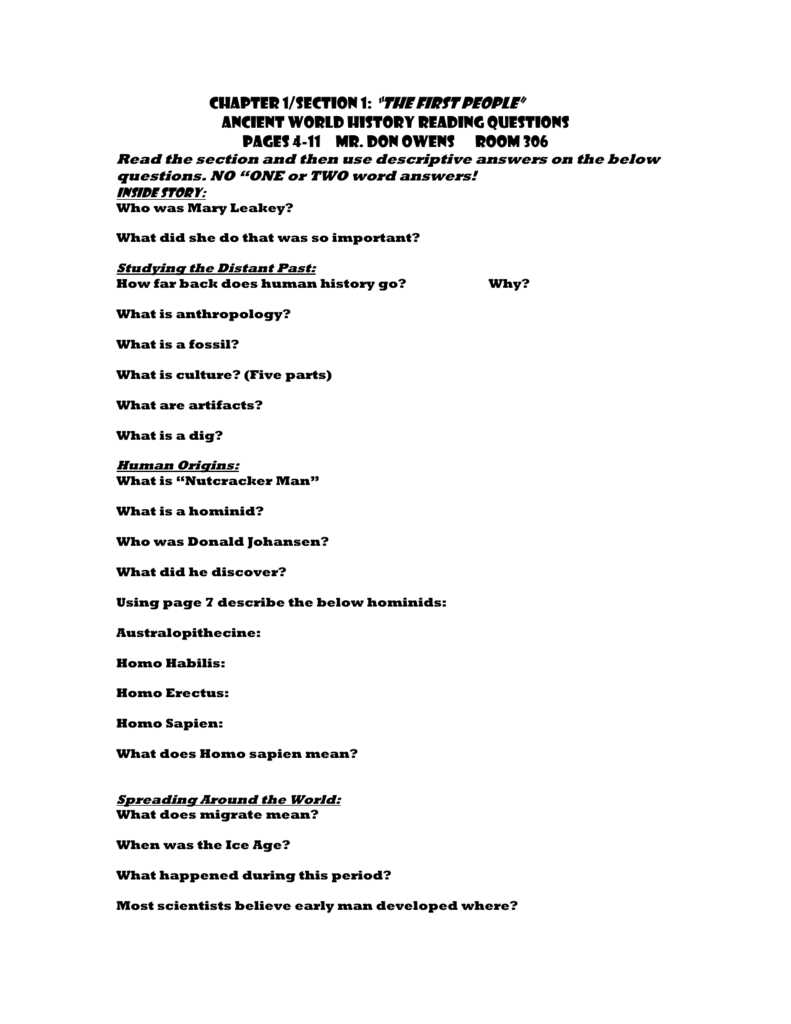
The history and origin of a subject is often a fascinating journey that sheds light on its development and significance. In the case of Section 1, we delve into the rich history and intriguing origins of this particular topic. By understanding its roots, we can gain a deeper appreciation for its evolution and impact in various fields.
Section 1 has a diverse range of historical and cultural origins, with influences from different time periods and regions around the world. To fully grasp its significance, it is essential to explore its journey through time and its connections to various civilizations and societies.
One of the earliest recorded instances of Section 1 can be traced back to ancient civilizations, where it played a crucial role in their daily lives and cultural practices. The origins of Section 1 can be found in the ancient texts and artifacts of civilizations such as the Egyptians, Greeks, and Romans. These societies recognized the importance of this subject and developed their own unique approaches to it.
Over time, Section 1 continued to evolve and adapt, influenced by the changing social, political, and technological landscapes. It found its way into different disciplines and fields of study, becoming an integral part of various academic and professional domains. Today, Section 1 continues to shape our understanding of the world and plays a vital role in numerous industries and sectors.
English Bulldog: An Iconic Breed
The English Bulldog is a breed that holds a special place in the hearts of dog lovers around the world. With its distinctive appearance and unique personality, it has become an iconic symbol of strength, loyalty, and determination.
Known for its muscular build, wrinkled face, and pushed-in nose, the English Bulldog stands out in a crowd. Its broad shoulders and sturdy frame give it a powerful presence, while its wrinkled forehead and expressive eyes reveal a gentle and kind nature.
Originally bred for bull-baiting, a popular sport in medieval England, the English Bulldog has come a long way since its violent past. Today, it is known for its friendly and docile temperament, making it an excellent companion for families and individuals alike.
Despite its tough exterior, the English Bulldog is a sensitive and affectionate breed. It thrives on human companionship and enjoys being part of a family. Its loyalty knows no bounds, and it will go to great lengths to protect and please its loved ones.
One of the most endearing qualities of the English Bulldog is its sense of humor. It has a knack for making people laugh with its comical antics and clown-like behavior. Whether it’s snoring loudly, snorting playfully, or rolling around on its back, the English Bulldog never fails to bring a smile to its owner’s face.
While the English Bulldog may not be the most active breed, it does require regular exercise to maintain a healthy weight and prevent obesity. Daily walks and playtime in a secure area are usually sufficient to meet its exercise needs.
The Origins of the English Bulldog

The English Bulldog is a breed that has a rich and fascinating history. Its origins can be traced back to ancient times, where it was used for various purposes. The breed was initially developed in England and was primarily used for bull-baiting, a popular sport during the medieval period.
Bull-baiting involved setting a bulldog against a bull, with the objective of bringing the bull down. The English Bulldog’s strong and muscular build, along with its tenacity and determination, made it the perfect dog for this brutal sport. Its powerful jaws and low center of gravity allowed it to grip onto the bull and hold on tightly.
Over time, bull-baiting was banned in England, and the English Bulldog’s purpose shifted. It began to be used for other activities, such as guarding and as a companion dog. Its loyal and protective nature made it an excellent guard dog, while its friendly and affectionate temperament made it a beloved family pet.
The English Bulldog’s distinctive appearance also played a significant role in its popularity. Its muscular body, broad chest, and strong jaws give it a unique and powerful look. Its wrinkled face and pushed-in nose are also characteristic features of the breed.
In recent years, the English Bulldog has faced some challenges. Due to its breeding history, the breed is prone to certain health issues, such as breathing difficulties and joint problems. However, responsible breeders are working to address these issues and improve the overall health of the breed.
| Characteristics | Description |
|---|---|
| Size | The English Bulldog is a medium-sized breed, with males typically weighing between 50-55 pounds, and females weighing between 40-45 pounds. |
| Coat | The breed has a short and smooth coat that comes in various colors, including brindle, fawn, and white. |
| Temperament | The English Bulldog is known for its gentle and affectionate nature. It is a loyal and protective companion, making it an excellent family pet. |
| Exercise | While the English Bulldog does not require a lot of exercise, it is important to provide regular walks and mental stimulation to keep them healthy and happy. |
| Training | The breed can be stubborn at times, but with consistent and positive reinforcement training methods, they can be trained effectively. |
Section 2: Characteristics and Physical Appearance

The English Bulldog is a breed known for its distinctive characteristics and physical appearance. It is a medium-sized dog with a muscular build and a compact frame. The breed is known for its wrinkled face, droopy jowls, and pushed-in nose. The head of an English Bulldog is large and square-shaped, with a strong jaw and prominent cheeks.
One of the most notable physical features of the English Bulldog is its short, stout stature. The breed has a low-slung body and a wide chest, giving it a sturdy and powerful appearance. The legs of an English Bulldog are short and muscular, providing it with stability and balance.
The coat of an English Bulldog is short, smooth, and dense. It comes in a variety of colors, including brindle, fawn, white, and pied. The breed’s coat requires minimal grooming, making it relatively easy to maintain.
The English Bulldog has a distinctive expression that is often described as “sour” or “grumpy.” This is due to the breed’s naturally wrinkled face and downturned mouth. Despite its grumpy appearance, the English Bulldog is known for its friendly and affectionate nature.
In addition to its physical appearance, the English Bulldog is also known for its unique temperament. The breed is generally calm, gentle, and patient. It is known to be good with children and other pets, making it an excellent family companion.
Overall, the English Bulldog is a breed that stands out for its distinctive characteristics and physical appearance. From its wrinkled face to its muscular build, this breed is truly one-of-a-kind.
The Distinctive Features of the English Bulldog

The English Bulldog is a breed known for its unique and distinctive features. These features contribute to the breed’s iconic and recognizable appearance. Here are some of the most notable characteristics of the English Bulldog:
- Compact and muscular body: The English Bulldog has a sturdy and compact body, with a muscular build. Despite their small size, they have a powerful and strong physique.
- Pronounced jaw and underbite: One of the most distinctive features of the English Bulldog is its pronounced jaw and underbite. Their lower jaw extends beyond the upper jaw, giving them a unique facial expression.
- Wrinkled face and expressive eyes: English Bulldogs have a wrinkled face, especially around the nose and forehead. These wrinkles add to their charm and give them a distinctive appearance. Their expressive eyes are usually round and set wide apart.
- Short and stout legs: The English Bulldog has short and stout legs, which contribute to its low and close-to-the-ground stance. Despite their short legs, they are surprisingly agile and can move quickly when needed.
- Wide and muscular chest: Another notable feature of the English Bulldog is its wide and muscular chest. This gives them a strong and robust appearance.
- Short and smooth coat: English Bulldogs have a short and smooth coat that is easy to maintain. They come in various colors, including brindle, fawn, white, and pied.
- Folded and rose-shaped ears: The ears of the English Bulldog are typically folded and set high on the head. Some Bulldogs have rose-shaped ears, which fold backward at the tip.
- Stocky and thick-set build: English Bulldogs have a stocky and thick-set build, with a broad chest and strong shoulders. This gives them a compact and solid appearance.
These distinctive features make the English Bulldog easily recognizable and beloved by many. They are a breed that stands out in a crowd and has a charm all their own.
The Lilac Tri Coloration
What sets the Lilac Tri coloration apart is its rarity. Bulldogs with this coat pattern are considered to be quite rare, making them highly desirable among breed enthusiasts. The unique combination of colors creates a visually stunning and eye-catching appearance that is sure to turn heads.
In addition to their striking appearance, Lilac Tri Bulldogs also tend to have a calm and friendly temperament. They are known for being affectionate, gentle, and good with children, making them great family pets. Their easygoing nature and willingness to please their owners make them relatively easy to train.
It’s important to note that breeding Lilac Tri Bulldogs can be a complex process. Breeders must carefully select and pair dogs with the desired color genetics to produce offspring with the desired coat pattern. This requires a deep understanding of genetics and a commitment to responsible breeding practices.
If you’re considering adding a Lilac Tri Bulldog to your family, it’s essential to choose a reputable breeder who specializes in this specific coat pattern. A reputable breeder will have extensive knowledge of color genetics and will prioritize the health and well-being of their dogs.
Section 3: Breeding and Pedigree

When it comes to breeding English Bulldogs, it is important to choose a reputable breeder who prioritizes the health and well-being of the dogs. The breeding process should be carefully planned and executed to ensure the production of healthy and genetically sound puppies.
One of the key factors to consider when breeding English Bulldogs is their pedigree. A pedigree is a record of a dog’s ancestry, showing the lineage and bloodline of the dog. It provides valuable information about the dog’s genetic background, including any potential health issues that may be present in the bloodline.
Choosing a Reputable Bulldog Breeder
When selecting a breeder, it is crucial to do thorough research and choose one who is knowledgeable and experienced in breeding English Bulldogs. A reputable breeder will be able to provide you with the necessary information about the dog’s pedigree, including any health clearances and certifications.
It is also important to visit the breeder’s facility and meet the parent dogs to assess their temperament and overall health. A responsible breeder will prioritize the health and well-being of their dogs, ensuring they are well-cared for and living in a clean and safe environment.
Additionally, a reputable breeder will be transparent about any potential health issues that may be present in the breed and will take steps to minimize the risk of these conditions through selective breeding and genetic testing.
By choosing a reputable breeder with a focus on breeding healthy and genetically sound English Bulldogs, you can ensure that you are getting a puppy that is more likely to live a long and happy life. It is essential to prioritize the health and well-being of these iconic and beloved dogs.
Choosing a Reputable Bulldog Breeder

When it comes to bringing an English Bulldog into your family, choosing a reputable breeder is of utmost importance. A reputable breeder will not only ensure that you are getting a healthy and well-socialized puppy, but they will also provide ongoing support and guidance throughout the life of your Bulldog.
Research and Recommendations

Start by doing thorough research on different Bulldog breeders in your area. Look for breeders who have a good reputation and a track record of producing healthy and well-adjusted puppies. You can ask for recommendations from local Bulldog clubs or veterinarians who specialize in the breed.
Visit the Breeder

Once you have identified a few potential breeders, schedule a visit to their facilities. This will give you an opportunity to see firsthand how the breeder cares for their dogs and puppies. Pay attention to the cleanliness of the environment, the overall health and condition of the dogs, and how the breeder interacts with their animals.
Ask the breeder about the health testing they perform on their breeding dogs. Reputable breeders will conduct tests for common Bulldog health issues such as hip dysplasia, cardiac abnormalities, and respiratory problems. They should be able to provide you with documentation of these tests.
Meet the Parents

While visiting the breeder, make sure to meet the puppy’s parents if they are available. This will give you an idea of what your Bulldog may look like and what their temperament might be. It’s important to choose a breeder whose dogs possess the traits and characteristics you desire in a Bulldog.
Ask Questions

Don’t be afraid to ask the breeder lots of questions. A reputable breeder will be happy to answer any concerns or inquiries you may have. Ask about the breeder’s experience with the breed, their breeding practices, and any guarantees or warranties they offer with their puppies.
Health Guarantee

A responsible breeder will offer a health guarantee for their puppies. This means that if your Bulldog develops a genetic health problem within a certain timeframe, the breeder will either refund your money or provide a replacement puppy. Make sure to carefully read and understand the terms of the health guarantee before making a commitment.
By choosing a reputable Bulldog breeder, you are setting yourself up for a positive and rewarding experience with your new furry friend. Remember to take your time, do your research, and ask plenty of questions. A well-bred and well-cared-for Bulldog will bring you joy and companionship for many years to come.
Section 4: Training and Temperament

When it comes to obedience training, English Bulldogs may not be the quickest learners, but with patience and repetition, they can become well-behaved companions. It’s important to keep training sessions short and engaging to hold their attention. Positive reinforcement is key, as Bulldogs respond well to praise and rewards.
Socialization
Proper socialization is crucial for English Bulldogs, as they can be wary of strangers and other animals. Expose your Bulldog to different environments, people, and animals from a young age to help them develop into confident and well-adjusted dogs. Gradually introduce them to new experiences, ensuring that each interaction is positive and rewarding.
Exercise Needs
Despite their stocky build, English Bulldogs require regular exercise to maintain a healthy weight and prevent obesity. However, it’s important to be mindful of their brachycephalic (short-nosed) nature, which can make breathing difficult. Avoid exercising them in extreme heat or for long periods of time.
Aim for short, low-impact exercise sessions such as leisurely walks or playtime in a fenced yard. Bulldogs also enjoy mental stimulation, so consider incorporating puzzle toys or training games into their routine.
Temperament

English Bulldogs are known for their friendly and affectionate nature. They are generally good with children and make excellent family pets. However, they can be stubborn and have a strong independent streak, so early training and socialization are essential.
While Bulldogs are not typically aggressive, they can be protective of their families and territory. Proper training and socialization can help prevent any potential behavioral issues. It’s important to provide them with a calm and stable environment, as they are sensitive to stress and loud noises.
| Training Tips for English Bulldogs |
|---|
| 1. Be patient and consistent. |
| 2. Use positive reinforcement techniques. |
| 3. Keep training sessions short and engaging. |
| 4. Socialize your Bulldog from a young age. |
| 5. Provide regular exercise, but be mindful of their breathing. |
By following these training tips and understanding the unique temperament of the English Bulldog, you can ensure that your Bulldog becomes a well-behaved and happy member of your family.

Tyler Newsom, a canine enthusiast, is passionate about bulldogs and their coat care. With years of experience and dedication, he shares his expertise to help bulldog owners maintain their beloved pets’ fur health and vitality through practical tips and advice.
